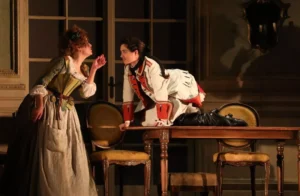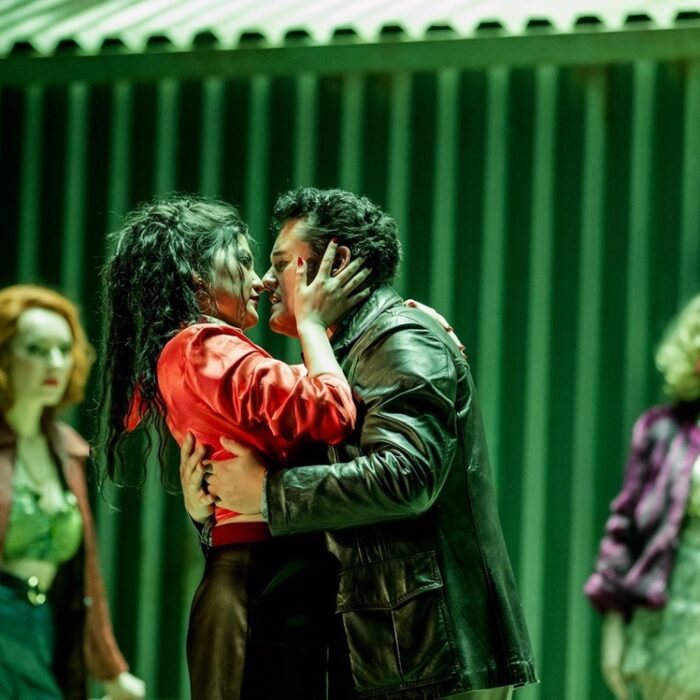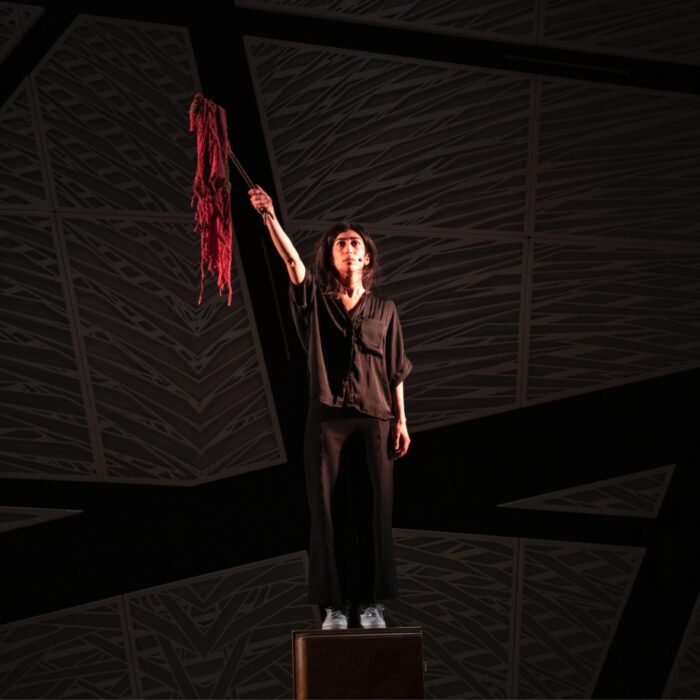
Teatro alla Scala 2022-23 Review: Li Zite Ngalera
Marcon & Muscato Oversee A Bright, Playful Presentation Of A Baroque Rarity
By Alan Neilson(Photo: Brescia & Amisano)
One of the more eye-catching works of Teatro La Scala’s current season is Leonardo Vinci’s “Li Zite Ngalera,” which has just finished a run of five performances.
Vinci was born between 1690 and 1696 in Italy’s Calabria region but was dead by 1730, possibly poisoned by a jealous husband. Yet during his short life, he was able to establish himself across the Italian peninsula with a string of successful “drama per musica,” operas on serious subjects such as “Artaserse,” “Alessandro nell’Indie” and “Catone in Utica,” works for which he is now largely remembered. However, his early success as a composer was achieved in Naples by writing “commedia per musica,” a comic theatrical entertainment that embraced the local folk music and dance to libretti written in the local dialect and populated mainly with low-born characters. In just five years, between 1719 and 1724, he wrote 11 such works, of which “Li Zite Ngalera,” with a libretto by Bernardo Saddumene, is the earliest surviving complete score. Although it premiered at Naples’ Teatro dei Fiorentini in 1722, this production marked its Milan premiere.
The narrative of “Li Zite Ngalera” is light but well-crafted to allow for plenty of comedic possibilities, although it has little to say beyond this. The story is based around a multiplicity of love entanglements, with the relationship between Carlo and Belluccia at its centre. Almost every character is in love with someone who loves someone else. Add in disguises and misunderstandings, cross-dressing and roles assigned to singers of the opposite sex, and everything is set up for a hilarious evening’s entertainment. The ending is as expected: Carlo and Belluccia are reconciled, and everyone else finds contentment of one sort or another.
Clear & Well-Focused Direction
The success of any comedy, of course, will largely depend on the director’s imagination and ability to respond to the comedic potential contained within the libretto, and in the case of La Scala’s production of “Li Zite Ngalera,” the director Leo Muscato displayed real insight, sensitivity and flair in bringing it to the stage. Every character and every scene were clearly constructed in order to maximize the fun. There was plenty of movement and plenty of color; the singers were encouraged to exaggerate their actions and reactions; every opportunity was taken to play up the comedy, such as the introduction of a parrot, which even became involved in a love scene as it joined in with the music, and the audience loved it! There was no attempt to delve into the inner torments that frustrated lovers can feel, although certain aspects certainly came out as the tale unfolded at what felt like a rapid pace.
The sets designed by Federica Parolini were brilliantly conceived. Each scene was individually constructed to create a believable physical context in which the action would take place. Many were finely detailed with compatible props, such as the scene in the kitchen, which had everything an 18th century cook could want. With so many scenes, however, it initially appeared that the set changes were hindering the dramatic flow, but this proved not to be the case. In fact, the movement of the sets, which slid on and off the stage, attaching to, or detaching from, an existing set or revealing another set behind it, was seamlessly managed and added to the rapid onstage movement, which fitted with the pace of the production. Often the sets had more than one level, which again allowed for further movement.
Silvia Aymonino’s pleasing costume designs were based around traditional 18th century clothing. They were very colorful, although occasionally slightly over-the-top for comedic purposes, and sat comfortably within the traditional set designs.
Overall, Alessandro Verazzi did a fine job with his lighting designs, successfully creating the changing atmosphere, although on occasion and partly as a result of the hats worn by some of the cast, the faces of the singers would be covered in dark shadows, which was not ideal.
The music is characterized by pleasing melodies with comparatively simple orchestration and thin textures, but with plenty of rhythmic variety and energy, which the musical director Andrea Macron and La Cetra Barokorchester, along with members of the Orchestra del Teatro alla Scala on period instruments, brought beautifully alive in a sparkling performance. Marcon was always sensitive to the needs of the singers, allowing the recitatives, arias and ensemble pieces to flourish, successfully drawing out the beauty and charm of the melodies. He also gave detailed attention to supporting and promoting the comedic-dramatic thrust of the piece, thereby ensuring the music and the staging were neatly dovetailed together.
Strong Cast Successfully Engages With The Comedy
The cast produced a wonderfully energetic performance, with the singers playing up the comedy for all its worth. It would not be an overstatement to suggest that rarely does one witness a cast so obviously enjoying themselves; the energy, positivity and sheer joy they were able to communicate to the audience were palpable throughout.
Although all the singers produced strong performances, there were a number that stood out, none more so than the tenor Alberto Allegrezza in the female role of Meneca Vernillo. Screeching and howling, wailing and moaning, he brilliantly exaggerated her emotions and overreacted to almost everything. It was all good fun, and the audience laughed along as the poor Meneca struggled to come to terms with her advancing years and forlorn hopes of attracting Belluccia, who is in fact a woman disguised as a man. It was also a superbly sung performance. Recitatives were lively and suitably over-the-top, and his catchy arias were given animated, strongly defined renditions, which not only caught the comedy but also the underlying emotional realities of her situation.
Baritone Marco Filippo Romano also created a convincing comedic performance as the apprentice Rapisto, who created an equally larger-than-life portrait, playing up the fun elements of his character to the full. His singing was expressive and versatile, which his opening aria, “Ai tempi oggi,” not only showed off to good effect but also drew attention to his voice’s attractive timbre.
Soprano Francesca Aspromonte, cast as Carlo Celmino, produced a beautifully detailed vocal presentation. Recitatives were precisely molded, carefully inflected with emotional and dynamic accents to promote their dramatic meaning, while the arias showed off her well-crafted phrasing and sensitivity to their emotional content and gave her the opportunity to show off her graceful, light coloratura.
Soprano Francesca Pia Vitale produced an engaging performance as the flirtatious Ciommerella Palummo, who is often at the centre of the many tangled love interests. She is in love with Belluccia, whom she believes to be a man, and is loved by Carlo, Col’Angolo and Titta, whom she brushes aside or plays with in a carefree manner. Producing a lively and energetic presentation, she captivated the audience with her free-flowing yet expressive and moving vocal depiction that drew attention to her lyrical beauty. She also rolled nicely with the comedic flow, for which she displayed a real flair.
On the other hand, mezzo-soprano Chiara Amarù as Belluccia Marino produced a low-key rather than an exciting performance, which was a little disappointing given the role’s comic potential, and she also proved to be vocally inconsistent. Whilst recitatives were neatly presented and carried the necessary dramatic force, the delivery of the arias varied in quality; her opening aria, “So’ sciore senz’adore,” although showing off the wonderful colors of her voice, never rose above the mundane, whereas her final aria “Si canoscissevo,” in which she teases Titta and Ciommerella, was beautifully rendered.
Having reviewed Antonio Siragusa’s impressive performance as Iago in Rossini’s “Otello” at last summer’s Rossini festival in Pesaro, it was interesting to see him again, but this time in a comic role. As the aging Col’Angolo who chased after the much younger Ciommerella, he convincingly developed the comedy of the situation as he hammed-up the part to the maximum in what was a confident, energetic and expertly crafted portrait. Likewise, his singing was well attuned to the character. His recitatives were creatively managed to bring out the comedy, and his arias sensitively uncovered the emotions, particularly the poignant “Come quando è notte oscura,” in which it dawns on him that he may be too old for such games.
Baritone Marco Filippo Romano also created a convincing comedic performance as the apprentice Rapisto, who created an equally larger-than-life portrait, playing up the fun elements of his character to the full. His singing was expressive and versatile, which his opening aria, “Ai tempi oggi,” not only showed off to good effect but also drew attention to his voice’s attractive timbre.
Countertenor Raffaele Pe was cast as the playful servant Ciccariello, who is always up to some sort of hi-jinx. It is yet another role with plenty of comic goings-on, which Pe happily engaged with and knowingly played up to the audience throughout the evening with an animated, confident and energetic performance. Vocally, he was on fine form, singing with plenty of vigor and brio and his ability to coat and accent the voice with a comic complexion was neatly rendered.
Although Titta Castagna is not a particularly high-profile role, countertenor Filippo Mineccia was still able to use it to show off the pleasing versatility, clarity and strength of his voice with an expressively taught vocal characterization.
Playing the role of Federico Mariano, bass-baritone Filippo Morace made his entrance from the back of the auditorium and sang his opening aria among the audience, watched on from the stage by the rest of the cast. Although it was a relatively small role, he made a strong impression.
Two young singers from the Solista dell’Accademia Teatro alla Scala, bass Matias Moncada and soprano Fan Zhou, were cast in the minor roles of Assan and the Slave Girl. Both produced quality performances. Moncada displayed a strong presence and produced a dignified and authoritative vocal display as Federico’s slave, while Zhou created a captivating portrait in which her light, graceful singing impressed.
Overall, this was an excellent production of an opera that is too rarely performed. It is genuinely funny, which the director, Muscato, and his team brought expertly to the stage. Vinci’s music has plenty of fine, immediately accessible melodies that Marcon and the cast presented with skill, energy and sensitivity, although if you are looking for florid passages of flashy coloratura and intricate ornamentation, then you will be disappointed as the arias are fairly simple in construction. If there was one drawback to the performance, it was that it lacked a degree of intimacy; La Scala is probably not the ideal venue for a work of this nature, despite the quality it can produce.



